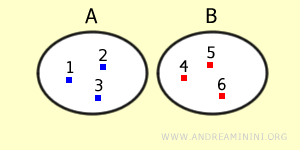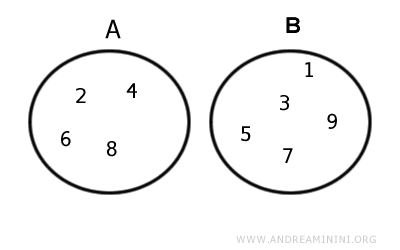Disjoint Sets
Two sets A and B are called disjoint sets when they share no elements in common.

When two sets are disjoint, their intersection is equal to the empty set. $$ A ⋂ B = Ø $$
A Practical Example
Set A consists of even numbers while set B is made up of odd numbers.
$$ A = \{ 2 \ , \ 4 \ , \ 6 \ , \ 8 \} $$
$$ B = \{ 1 \ , \ 3 \ , \ 5 \ , \ 9 \} $$
Sets A and B do not share any common elements.
In a graphical representation using Euler-Venn diagrams, the two sets do not overlap.

Their intersection is equal to the empty set.
$$ A ⋂ B = Ø $$
Therefore, sets A and B are disjoint sets.
And so on.
